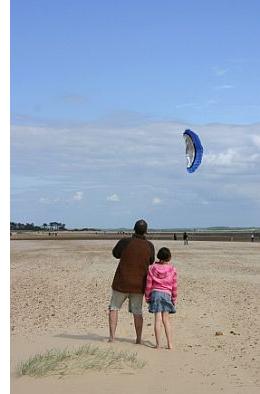- Home Page
- Stunt Kites
- Dual-Line Parafoil
Dual Line Parafoil Kites
Fast and Furious!
Dual-line parafoil kites come in a range of sizes and most are built for pure stunt-flying fun. Others are built for speed, the record being over 150 kph! A soft dual-line stunt kite pulls harder on the lines than an equivalent-sized delta and requires more line movement to maneuver.
If you've ever been up close to a steerable parafoil, it's easy to see how it's made. It has an upper surface, a lower surface, and a whole lot of dividers in between. Typically, there are between 10 and 20 such dividers.
Thus the kite is made up of many cells, each one open at the front edge of the kite. During flight, air rushes in and pumps up the kite to form an efficient hard-pulling wing.
Some of the cheapest kites use plastic, but any decent dual-line parafoil is constructed of ripstop nylon or polyester. Like the stuff sailing spinnakers are made from, this material is very strong for its weight and is tear resistant.
"Ripstop"—a small rip will stop before going very far!
On this site, there's more kite-making info than you can poke a stick at :-)
Want to know the most convenient way of using it all?
The Big MBK E-book Bundle is a collection of downloads—printable PDF files which provide step-by-step instructions for many kites large and small.
Every kite in every MBK series.
The Bridles
The exact designs vary somewhat from kite to kite. But in general, the left upper underside of the kite is attached to a number of quite short bridle lines. These lines all come together to a thicker single line, which in turn connects to the left flying line.
There is an identical mirror-image arrangement of bridle lines on the right-hand side of the kite. Thus, the two flying lines restrain the kite. Pulling the left line causes the kite to loop left. Similarly, pulling the right line causes the kite to loop right. The more you pull, the tighter the turn, up to the limit of the kite's performance.
Lines and Handles
 Beach flying is best!
Beach flying is best!Anything that's strong enough will work, but the most popular line materials are Dacron (a brand of polyester) and Spectra (a special type of polyethylene). Nylon is usable too, but it feels like you are flying with rubber bands! Dacron is better than nylon and is popular for single-line kites too, where stretch doesn't matter at all.
Spectra, which happens to be very low-stretch, is the ultimate mass-produced line material for multi-line kites. It is extremely strong for its weight too. Hence, a set of Spectra lines can be quite thin and still do the job. Thin lines have less air resistance and let the kite move faster through the air. Do you have the need for speed?
Here's one little-known fact... Apparently, Spectra has a relatively low melting point. This means friction from lines of other materials can easily slice it through despite its high tensile strength at lower temperatures. Gulp. Don't tangle with other kites.
Let's move on to handles. The pricier kites often come with a bar, as opposed to two separate handles. This arrangement offers more comfortable and precise flying, particularly with the larger kites. If the bar is anchored by your body, that takes a lot of stress off your arms while you fly. Wind surfers do this all the time.
Dual Line Pilots
 Photo courtesy of Sookie
Photo courtesy of SookieYes, if you fly a dual-line parafoil kite, you are entitled to call yourself a pilot! Well, make that a kite pilot to be more precise.
Age
Adults are stronger than young teens, who in turn are stronger than even younger children. A person's strength and weight determines how much kite pull they can safely handle. Although other design factors can influence how hard a kite pulls in any given wind speed, the main one is simply size. More sail area equals a stronger pull on those flying lines. Hence, it pays to take notice of the age ratings on dual-line power kites. Also, be careful about taking any big kite out in strong wind conditions!
Skill/experience
Among a group of pilots the same age, those with superior kite-handling skills will be able to safely fly somewhat bigger kites. They know how to position the kite to reduce the pull when necessary—not to mention when to give up and let go or use the de-power feature! But then, their superior knowledge would probably lead them to not even attempt to fly in such conditions.
Have fun! Picture yourself on the sand, in a stiff smooth breeze. (The kite in the photo looks like it has a couple of brake lines as well but it's essentially being flown as a dual-line kite.)
As mentioned earlier, there's more kite making on this site than you can poke a stick at. :-)
Want to know the most convenient way of using it all?
The Big MBK E-book Bundle is a collection of downloads—printable PDF files that provide step-by-step instructions for many kites large and small.
That's every kite in every MBK series.
